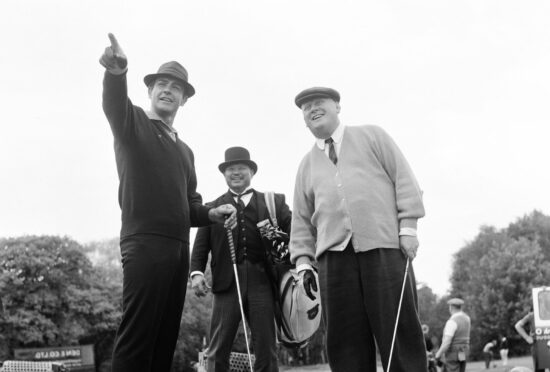
A first edition copy of Ian Fleming’s 007 novel Goldfinger, inscribed by the author to legendary golfer Sir Henry Cotton, could fetch a record price at auction.
The 1959 book features a famous golf match between James Bond and Auric Goldfinger in which the secret agent wins $10,000 from the villain after both use underhand tactics to win.
Fleming, who described the grudge match over 21 pages in his novel, presented the inscribed copy to his friend, the three-time Open champion Sir Henry, who was a fellow member at the Royal St George’s golf club in Kent.
Inside the 63-year-old hardback, the author wrote: “To Henry Cotton, Who may be amused by pp.92-113, Ian Fleming”.
The book, still in “excellent” condition, will go under the hammer in Lyon & Turnbull auctioneers’ sale of Rare Books, Manuscripts, Maps & Photographs on Wednesday.
Valued at up to £40,000, it is expected to attract bids from Bond collectors as well as those with an interest in golf.
Cathy Marsden, Lyon & Turnbull’s Assistant Head of Rare Books, Manuscripts and Photo, said: “Goldfinger was first published in 1959, and centres on James Bond’s investigation into Auric Goldfinger’s gold smuggling activities.
“Pages 92-113 of the novel concentrate on a golfing contest between Bond and Goldfinger, who dislike each other intensely. Goldfinger attempts to claim victory by cheating, but Bond, of course, wins the game.
“This scene reflects Ian Fleming’s passion for golf. Bond enters the match with a handicap of nine, the same as the author’s, and the match takes place at the fictional Royal St Marks Golf Course, a location based on Fleming’s golf club, Royal St George’s at Sandwich in Kent.
“Sir Henry Cotton was also a member of Royal St George’s and the two men formed a friendship.”
Goldfinger was the seventh in Fleming’s series of novels featuring secret service agent 007.
Later made into a movie classic starring the late Sir Sean Connery as 007, the film’s famous golf scene also introduced fans to one of the Bond franchise’s most popular characters, Goldfinger’s henchman Oddjob.
In his memoir, Connery revealed the scene sparked his own love of golf, writing: “I began to take lessons on a course near Pinewood film studios and was immediately hooked on the game. Soon it would nearly take over my life.
“During the filming of Goldfinger, I learned the essential challenge of links golf at Royal Dornoch in the north-east Highlands. Ever since then I have been drawn to links golf and its challenges.”
Sir Henry Cotton won the Open in 1934 at Royal St George’s, in 1937 at Carnoustie and in 1948 at Muirfield. He also captained Britain’s Ryder Cup team.

Enjoy the convenience of having The Sunday Post delivered as a digital ePaper straight to your smartphone, tablet or computer.
Subscribe for only £5.49 a month and enjoy all the benefits of the printed paper as a digital replica.
Subscribe